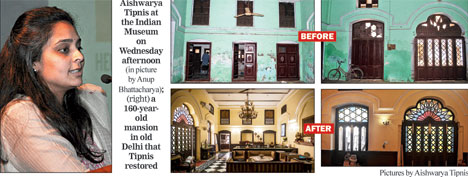Calcutta:
A young architect working on heritage structures in Chandernagore busted several myths about conservation of old buildings at a lecture at the Indian Museum on Wednesday afternoon.
“Conservation is no rocket science. It is far from a Nasa code that can’t be cracked,” said Aishwarya Tipnis.
An alumnus of the School of Planning and Architecture in New Delhi, Tipnis won the Chevalier des Artes et des Lettres, France’s top cultural award, this January for her “outstanding commitment” to the preservation of French heritage in Chandernagore, where she has been working for eight years.
The 37-year-old debunked the common perception that conservation is opposed to development, stressing that it is in fact a part of it.
The lecture, titled Why Does Heritage Conservation Even Matter To Anyone, took the audience through a presentation that told the story of Tipnis’s first big project – the restoration of a 160-year-old mansion in old Delhi, which started in 2010.
The current owner of Seth Ram Lal Khemka Haveli at Kashmere Gate in Shahjahanabad, Deoki Nandan Bagla, wanted to spruce up the house before his sons’ marriage. The three-storeyed house had been home to Bagla’s grandparents since 1920. Lack of renovation had created large cracks on floors and walls and several doors and windows were missing.
It was one of the first private conservation projects in the capital and went on to become a torchbearer for conservation of several old mansions. But the journey wasn’t smooth. The first challenge came from the client himself. Bagla wanted to turn it into a contemporary home. “What is restoration? Make the haveli modern,” he told Tipnis.
But Tipnis managed to convince him that compromising on the house’s principle architectural and aesthetic values was not a smart choice. “I told him everybody had a fancy home. But a palatial mansion was rare. He could show it off as a status symbol to the families of prospective brides.”
The finer details of the conservation were not as important to Bagla as his family’s pride. The point Tipnis drove home was that “architects have to get off their high horses” and connect with people.
One of the key aspects of traditional architecture was lime mortar plastering instead of cement. It led to setting up a lime mortar chukki in the courtyard of the mansion. After several failed experiments – with everything from urad dal and gur to methi seeds – a traditional lime plaster was ready to be caked on the walls.
The project also proved that conservation did not need to be an extremely expensive affair and jugaad could go a long way in bringing down the costs. Instead of using imported beams, Tipnis and her team used stainless steel beams made in Bagla’s factory.
The main lesson of the project was that heritage must continue to be relevant for conservation. “The day it loses relevance, no amount of legislation can preserve it,” said Tipnis.
source: http://www.telegraphindia.com / The Telegraph,Calcutta,India / Home> Calcutta / by Debraj Mitra / April 05th, 2018
